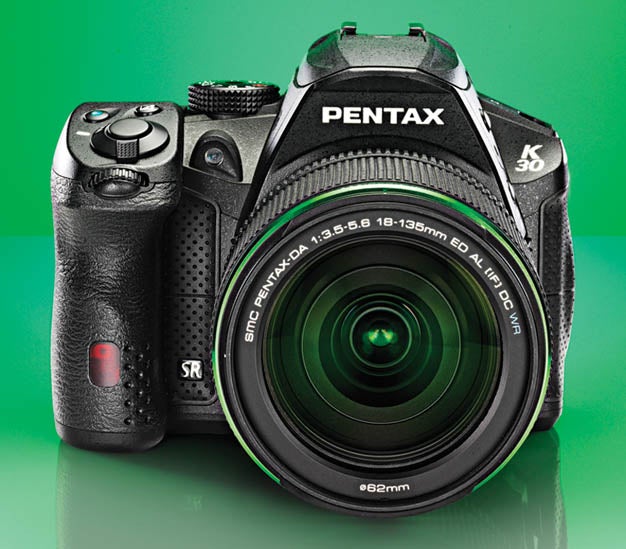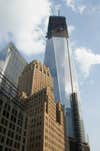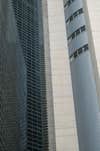Camera Test: Pentax K-30
A favorably priced starter DSLR with some advanced features

We may earn revenue from the products available on this page and participate in affiliate programs. Learn more ›
The new 16MP K-30 might be Pentax’s least-expensive DSLR, but it’s far from “entry level.” First off, it’s fully weathersealed: Pair it with one of Pentax’s weathersealed lenses, such as the 18–135mm f/3.5–5.6 WR kit lens or one of the premium optics in the DA* line, and you can shoot in a storm. Add to that a pair of command wheels, a 100-percent-accurate pentaprism finder, and 6-frames-per-second bursts, and you’ve got a camera that lives up to its more-than-entry-level pricing ($850, body only). How does it perform? Let’s see.
In the Lab
With just enough resolution to eke out an Excellent rating, plus amazingly accurate colors and noise rated Low or better to ISO 400, the Pentax K-30 earned an Excellent rating in overall image quality at ISO 100. As sensitivity rises, resolution falls just below our cutoff, earning a rating of Extremely High at ISO 200 and 400.
We always test RAW files converted to TIFFs using (at default settings) the software that comes with the camera. But we shoot our test targets in RAW + JPEG, since looking at the way a camera handles JPEG capture often proves instructive. The K-30, for JPEGs straight from the camera, scored an image quality rating of Extremely High from ISO 100 through ISO 800.
Why? Pentax treats RAW and JPEG shooters differently. Noise reduction is set low as a default in its RAW conversion software (a customized version of Silkypix), letting you decide how much resolution-robbing NR to apply. Thus, the noise scores in our test don’t look very good: The K-30 reaches Unacceptable by ISO 1600. But JPEGs captured simultaneously with the RAW files reach Unaccep-table only at ISO 6400—quite a leap.
JPEGs also showed much less resolution, though enough for photographers who don’t plan to print big. At ISO 100, 16-bit TIFFs converted from RAW files yielded 2510 lines per picture height; JPEGs turned in 2330 lines. At ISOs 800 and 12,800, the RAWs resolved 2370 and 2050 lines, respectively, while JPEGs yielded 2290 and 2030 lines at the same ISOs.
Color reproduction? Stellar. In our test it scored a remarkable Delta E of 5.0 (most DSLRs, at any price, land at around 7.0), easily earning it an Excellent rating.
In our autofocus test, the K-30 proved fast in bright light, but slowed sharply when the light dimmed. At the brightest level (EV 12), it took 0.33 sec to focus and capture an image. At the living-room light level of EV 6, it slowed to a still-impressive 0.54 sec. But by the time it got down to EV 1, the equivalent of a nighttime scene, it took 0.99 sec to focus. And AF slowed to 1.58 sec at EV 0 and an average of 1.79 sec at EV –1, the dimmest light in which Pentax rates AF as effective. Here it became erratic, varying from about 1.5 to more than 2 sec.
In the Field
With a deep grip, dual command wheels, and plenty to customize, the K-30 offers more control over settings and interface than any true entry-level camera on the market. You choose what the command wheels control in various exposure modes—which one sets aperture or shutter speed in manual mode, for example, or which one sets exposure compensation in aperture- or shutter-priority mode. Once you have the controls set the way you like them, you can save your settings to one of two custom groupings accessed using the mode dial. This way, various family members can quickly bring the camera back to their favorite settings in a snap. Or, you could program settings for different shooting scenarios.
We found the controls easy and fast to use, but we did run into a couple of quirks. Our camera went into sleep mode if no buttons were pressed within 1 minute (a firmware update may fix this soon); overriding the default to set the camera to wait 10 minutes before sleeping solved this. And, to select AF points you use five navigation buttons that double as control buttons for settings such as ISO and white balance—you must hold the OK button for about a second to toggle between selecting an AF point and changing the other settings. Once we got used to it, we found this efficient, though not intuitive.
Exposure compensation allows for up to +/– 5 EV in steps of 1/2-and 1/3-stops. Autobracketing allows for only three frames in +/–2 EV steps, but for a camera in this class, that’s good.
The automatic HDR function does a good job of creating images with wide dynamic ranges, and its auto-align function works well. With the intensity of the effect on low or medium settings, our results were fine.
The burst speed? Up to 6 frames per second for up to 30 JPEGs or 8 RAW shots. Continuous AF does a decent job of keeping up with moving subjects, similar to other cameras in its price range, but you shouldn’t expect the same level of subject tracking that you’d get from a pricier DSLR.
The K-30 can capture very nice video at up to 1920×1080 pixels at up to 30 frames per second. Footage we shot was plenty sharp, with solid color saturation and only minimal video artifacts. Sadly, there’s no mic input, so you’ll have to run separate audio or accept that of the built-in monaural microphone.
Bottom Line
Pentax’s DSLRs have always formed their own niche in the camera market. While Canon and Nikon’s lines tend to mirror one another, Pentax’s “entry-level” DSLRs have always tended to be more feature-laden than the most basic models from the Big Two. For instance, while last year’s Canon EOS Rebel T3i costs about $150 less than the Pentax K-30 when both are paired with their 18–135mm f/3.5–5.6 kit lenses, the T3i and its lens lack the K-30’s weathersealing and can’t keep up with its rapid bursts.
Furthermore, the K-30’s sensor-shift image stabilization, which afforded our testers an average of 3 stops of hand-holding leeway, works with any lens you mount on the camera. Shoot with a Lensbaby? It’s stabilized. Try a 1950s-era screw-mount lens? Stabilized. With Canon or Nikon, you’ll have to shell out more bucks for optically stabilized lenses.
If you like the idea of a cost-effective DSLR that is weather-sealed, has enough resolving power to satisfy nearly all photo-graphic needs, and has a faster burst rate than most of its price range, you won’t go wrong with the K-30.
SPECIFICATIONS:
IMAGING: 16.3MP effective, APS-C-format CMOS sensor captures images at 4928×3264 pixels with 12 bits/color in RAW mode.
Storage: SD, SDHC, and SDXC. Stores JPEG, DNG RAW, or RAW + JPEG files.
VIDEO: Records up to 1920x1080p pixels at 30 or 24 fps in MPEG-4 H.264 format; built-in monaural microphone; no microphone input; continuous AF available; approx. 25-min maximum clip size at highest quality.
BURST RATE: Full-sized JPEGs (Best Quality), up to 30 shots at 6 fps; RAW, up to 8 shots at 6 fps.
AF SYSTEM: TTL phase-detection with 11 illuminated focus points (9 cross-type points in center); single-shot, continuous, auto (automatically chooses single or continuous); tested sensitivity down to EV –1 (at ISO 100, f/1.4).
LIVE VIEW: Full-time contrast detection, or single-shot phase-detection AF with mirror interrupting view momentarily.
SHUTTER SPEEDS: 1/6000 to 30 sec, plus B (1/3-or 1/2-EV increments); shutter life not rated; flash sync to 1/180 second.
METERING: TTL metering using 77 -segment system; multi-segment (evaluative), centerweighted, and spot (approx. 5% of finder at center); range, 0–20 EV (at ISO 100).
ISO RANGE: ISO 100–12,800 (in 1- EV steps), expandable to ISO 100–25,600.
VIEWFINDER: Fixed eye-level pentaprism.
LCD: Fixed 3-in. TFT with 921,000-dot resolution, 15-step brightness adjustment.
OUTPUT: Hi-Speed USB 2.0, mini-HDMI video, and composite video.
BATTERY: Rechargeable D-LI109 Li-ion; CIPA rating, 480 shots with optical viewfinder.
SIZE/WEIGHT: 5.1×3.8×2.8 in., 1.4 lb with a card and battery.
STREET PRICE: $850, body only; $900 with 18–55mm f/3.5–5.6 AL zoom lens; $1,050, with 18–55mm f/3.5–5.6 AL and 50–200mm f/4.0–5.6 AL zoom lenses.
INFO: www.pentaximaging.com
















